The 10 Best pH Meters For Your Aquarium in 2025
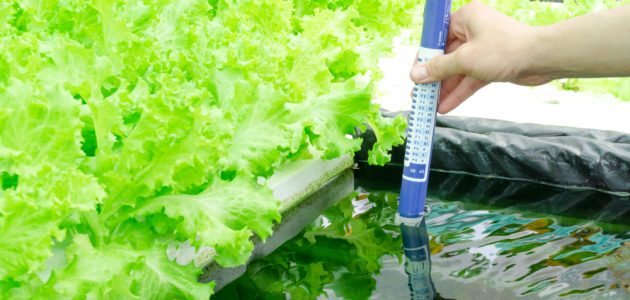
Whether you have a luxurious saltwater aquarium or a small freshwater goldfish tank, getting a pH meter should be one of your first priorities. You’ll be able to make sure that your fish and plants in your tank are growing in their optimal environment, and keep them safe from some preventable illnesses.
While getting accustomed to pH meters and the pH scale can be difficult at first, we’re here to walk you through the process of picking out the perfect one and using it to see how well your aquarium is doing.
- How to Choose the Right pH Meter
- Top 10 Best pH Meters 2025
- 1. Best Overall pH Meter: Apera Instruments AI209 Value Series
- 2. Best Premium pH Meter: Bluelab Combo Meter for pH
- 3. Best Budget pH Meter: Tetra EasyStrips 6 in 1 Aquarium Tester
- 4. Best Comprehensive pH Meter Testing Kit: Apera Instruments AI316 Premium Series
- 5. Best Waterproof pH Meter: Bluelab pH Pen
- 6. Best pH Meter Tests to Buy in Bulk: Runbo Aquarium 6 in 1 Test Strips
- 7. Easiest pH Meter to Calibrate: Hayi Digital pH Meter for Aquarium Water
- 8. Best pH Meter for Comprehensive Water Status: API Test Strips
- 9. Best Digital pH Meter for Beginners: Vivosun pH and TDS Meter Combo
- 10. Best Affordable Digital pH Meter: Pancellent Water Quality Test Meter
- Guide to Picking the Perfect pH Meter
- Final Words
How to Choose the Right pH Meter
The right pH meter will be easy to use and accurate enough that your aquarium and all the living beings inside can thrive. While accuracy is the most essential element in choosing a pH meter, there are a variety of factors you should consider before picking one out.
Types of pH Meters
When it comes to choosing a pH meter, there is no shortage of options. Before you even begin looking at your choices, you’ll want to have a basic idea of which type of pH meter you’d be interested in. All pH meters can be classified as either manual or digital. Both have their respective perks and downsides, which we’ll explore more here as well.
Manual pH Meters
Manual pH meters are a cheaper option for those who are just getting started and can be easy to use. They usually come in a small kit that you won’t have to worry about cleaning, and you simply place the strips in water and wait for it to change color to indicate the pH of the water.
However, they’re not as accurate as digital pH meters. It also takes a bit of time for them to get a pH reading. You’ll also have to use new strips each time and throw out the old ones, though manual pH kits come with multiple strips so you won’t run out. If you don’t plan on testing pH often, this is the more budget-friendly option.
Digital pH Meters
If you’re always concerned about the pH of your aquarium or water, digital pH meters are the way to go. They’re also more accurate than manual kits and pH test strips depending on the option that you purchase since some can go to multiple decimal places. They’re also much quicker in getting a reading and are meant to be reused over many years.
However, they’re also more expensive than traditional pH test strips, so they’re definitely an investment you’re making to keep your aquarium healthy. In addition, you’ll need to take good care of cleaning and calibrating the meter often to make sure that it works at full capacity and doesn’t break down.
Features to Consider When Buying pH Meters
When it comes to choosing a good pH meter, there are a lot of factors that you’ll want to consider and balance. Depending on how delicate the balance of your aquarium and refugium may be, you might not need to buy the most expensive meter on the market!
Accuracy
One of the more important considerations for pH meters is accuracy. Less accurate meters, such as manual ones, are less expensive. If your aquarium is one where you only need to know about where the pH is rather than the exact pH reading, you can opt for a cheaper meter that may not be as accurate.
However, if your aquarium or refugium needs a very specific pH, you’ll want to make sure your meter can give precise, accurate readings consistently. The most accurate pH meter that we have is the Apera AI316 Series.
Ease of Use
Some pH meters are more advanced, and as a result, you’ll have to tinker with the calibration settings when you get it out of the box. Others can be used as soon as you receive it, with special buttons to help with calibration and detailed manuals. Easier pH meters are preferable, but if you want something truly tailored for your aquarium, you might want to go for a meter with many more options for customization.
Power and Portability
Some pH meters are large or heavy and drain battery sources quickly. Others might even need to be plugged into an outlet to work, making it less ideal for when you’re on the go and need to measure pH. Taking into account the power required for certain pH meters along with the portability of the meters can make a difference, especially if you plan on traveling. The Apera AI209 Series.
Display
Make sure that your pH meter is easy to read and decipher, whether it’s through sharp contrasts of color on the pH strip or a clear digital display when it’s used. Having backlights to your digital display can also be good, in case you plan on testing pH in dimly lit areas. The Bluelab combo meter is one example of a pH meter with a large display that’s easy to read.
pH Range
Not all meters can read all ranges of pH. While this is usually fine, you’ll want to make sure that your aquarium situation doesn’t need a pH reading outside of the usual range in the meters. The standard range for pH meters is from 0 to 14, but a few can go from -2 to 16 depending on what you’re using it for. Manual meters may have lower ranges.
Any pH meter on our list will handle the 6-8 range that almost all common aquarium fish use, but if you’ve got a less common species be sure to read more about the proper pH in our guide below.
Getting a good balance between all the factors is the best way to make sure that you choose the perfect meter without draining your bank account. Now that we’ve covered the basics for buying the right pH meters, here are our top choices that are both reliable and affordable!
Top 10 Best pH Meters 2025
1. Best Overall pH Meter: Apera Instruments AI209 Value Series
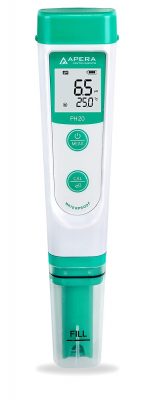
Editor’s Rating:
Why we like it: The Apera Instruments AI209 pH meter comes in a portable container and lasts up to 2,000 hours once you get batteries in. The large LED display makes taking measurements easy, and the meter comes with a care kit so that you can keep it clean and functional.
Quick Facts:
- Accuracy: +/- 0.1°
- pH Range:0 – 14.0
- Power Source: 4 x AAA alkaline batteries
- Type: Digital
This Apera Instruments pH meter can last up to 2,000 hours when equipped with four batteries, so you’ll never have to worry about running out of power! It is easy to calibrate and comes with a special brush for cleaning the probe so that you and keep it in top condition. In addition, calibration solutions are also included, and the calibration function makes the process a breeze.
However, if you’re not careful and gentle with the probe while taking measurements, you may get air bubbles trapped in the glass sensor that can disrupt future readings. This probe also needs a little more time in the water to get a good reading. It takes close to a minute, which is significantly longer than other digital pH probes—if you don’t mind the extra cost and slightly lower durability, the Bluelab Combo Meter is a speedier alternative.
The case that the probe arrives in is heavy duty so you’ll be able to transport the probe anywhere without worry of breaking it. The ATC (auto temperature compensation) is also spot-on for anywhere from 32 degrees to 122 degrees. It also alerts you when it’s running low on battery, and the large LED display shows the pH, temperature, and small icons so you know the status of your aquarium water at a glance.
Pros
- Lasts 2,000 hours on 4 batteries
- Come with a cleaning brush and care kit
- Includes two calibration solutions
- Arrives in a heavy-duty case for transportation
- A large LED display shows all the information at a glance
Cons
- Air bubbles can get trapped in the glass probe
- Takes longer than other digital probes to measure pH
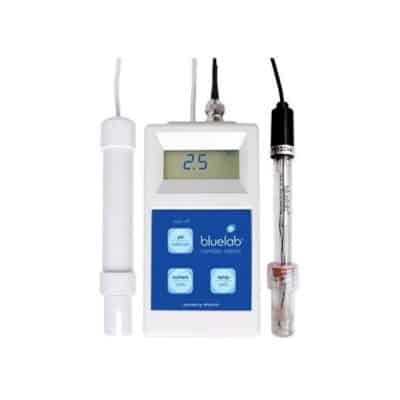
Editor’s Rating:
Why we like it: The Bluelab combo meter comes with two probes for quick and accurate measurements when put into water. Paired with a strong communication system, you’ll know exactly what the pH of your water is and the status of your pH meter.
Quick Facts:
- Accuracy: +/- 0.1°
- pH Range:0 – 14.0
- Power Source: 2 x AAA alkaline batteries
- Type: Digital
The Bluelab combo meter measures pH, conductivity, and temperature at the same time, with accurate readings for all three. The dual probe setup also makes this a more accurate pH meter when compared to other meters. In addition, the display for this meter is much larger when compared to the pH pens on this list, so you’ll be able to easily see the display showing all the numbers.
It also offers warnings if the pH is out of range and if the battery runs low, which is something that other meters don’t offer. When it’s time for calibration, you’ll get a signal as well from the meter.
Because this probe is accurate and complex, it is also easy to break if you’re not careful with it. The delicate design of the probe means that it can be damaged easily when you’re not careful. You’ll also have to keep in mind that the entire device is not waterproof – however, the probes for testing pH are. If you don’t mind losing a bit of functionality in favor of durability, the lab-grade digital Bluelab pH Pen might be what you need.
In addition to the extra functions and warning, it will also turn off after an extended period of inactivity to conserve battery. It also comes with a 5-year limited warranty, and if you take good care of it, you’ll be able to use it for a lifetime.
Pros
- Dual probes make this a more accurate and precise meter
- 5 year limited warranty
- Measures pH, conductivity, and temperature
- Warning for low battery and out of range pH
- Tells you when it needs to be calibrated again
Cons
- More delicate pH meter
- Only the probes are waterproof
3. Best Budget pH Meter: Tetra EasyStrips 6 in 1 Aquarium Tester
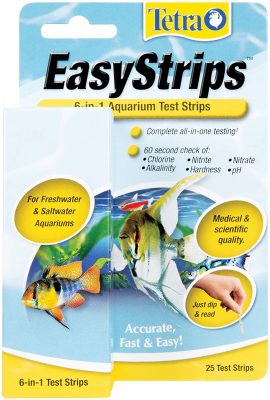
Editor’s Rating:
Why we like it: The Tetra EasyStrips pH tester gives you a quick overview of your water quality without costing too much. The color chart is simple to read and decipher, and you’ll be able to know your water quality after submerging these strips for 60 seconds.
Quick Facts:
- Accuracy: +/- 0.4°
- pH Range:2 – 8.4
- Power Source: NA
- Type: Manual
These pH testing strips come in a box of 25, perfect if you don’t plan on testing water pH every day. They check levels of chlorine, alkalinity, hardness, nitrite, and nitrate in addition to giving you the pH levels of the water, all of which can impact the health of your fish. This company also sells strips for testing ammonia levels in your tank.
Keep the pH range in mind before purchasing the strips, since they don’t cover a wide pH range. These won’t be able to help fish that need to be in more acidic or basic water. In addition, they will expire after a certain amount of time so you want to make sure you use it up before the date printed on the cover. As always, since this is a manual pH meter, it won’t be as accurate either. The color chart for this meter is on the back of the bottle that holds the strips, so you will have to remember to peel it off in order to compare hues.
However, you can still have a healthy tank without knowing the exact pH, as long as you’re able to keep the water in the right range. It’s an affordable option if you want to get a general idea of how well the water is working out for your fish, and they only take 60 seconds to get an accurate reading.
Some strips can get readings faster, such as the Runbo aquarium test strips which only takes 2 seconds.
Pros
- Comes in a box of 25
- Affordable option to get a general overview of water quality
- Tests six elements of water, including pH levels
- Takes only 60 seconds to get an accurate reading
- Designed specifically for aquariums
Cons
- Not as accurate as digital meters
- Has a lower range of pH levels
- Expires after a some time
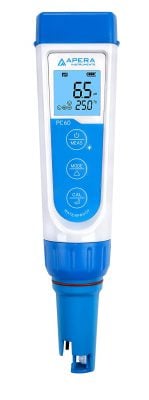
Editor’s Rating:
Why we like it: The AI316 pH meter measures pH, temperature, conductivity, salinity, and TDS (total dissolved solids) at a very accurate rate. In addition, the kit comes with enough buffer solutions and containers to help you get started with calibrating your pH meter.
Quick Facts:
- Accuracy: +/- 0.01°
- pH Range: -2.00 – 16.00
- Power Source: 4 x AAA alkaline batteries
- Type: Digital
This pH kit comes with enough buffer solutions and containers to give you everything you need for the first calibration. With an extensive instructional guide on the front of the kit, you’ll be able to get started even if you’ve never used a pH meter before. The built-in calibration function recognizes 5 different pH buffer solutions as well, which is more than the other meters in this list. The meter itself can test for pH, conductivity, TDS (total dissolved solids), salinity, and temperature all at once.
It is an expensive option, but one that gives you much more consistency and accuracy. The range of pH that this meter covers is far larger than other choices, though you likely won’t need the extremes when using it for your aquarium tank. If you want one that’s just as accurate but not as expensive, check out the Apera AI209 Series, but you won’t get as many added accessories with that meter.
It also needs to soak overnight for the first calibration and to get rid of air bubbles, so don’t plan on using it the day it arrives in the mail. The glass probe is also more delicate than some of the other options so you need to take extra care when using this meter. In addition, while the probe is delicate, it is also replaceable, so you won’t have to purchase an entirely new meter if the probe breaks.
Pros
- The calibration function recognizes five different buffers
- The kit arrives with calibration containers and solutions
- Measures five different elements in the water
- The probe is replaceable if it breaks
- An in-depth instruction manual is included in the kit
Cons
- More expensive option
- Glass probes are delicate
- Needs to soak overnight to calibrate
5. Best Waterproof pH Meter: Bluelab pH Pen

Editor’s Rating:
Why we like it: The Bluelab pH pen is a high-quality meter that accurately measures pH levels consistently. It’s fully waterproof, and this is one of the only meters that can be completely submerged in your aquarium for fast testing.
Quick Facts:
- Accuracy: +/- 0.1°
- pH Range:0 – 14.0
- Power Source: AAA alkaline battery
- Type: Digital
This pH testing pen has a high-quality glass probe for detecting pH levels and is easy to calibrate. It’s one of the few meters that’s completely waterproof and can be submerged in your aquarium. The LCD display showing the pH level also has a backlight so it won’t be hard to read when you’re using it in a dim atmosphere. In addition, the meter provides calibration reminders so you know whenever you’ll have to get out those buffer solutions again!
It’s definitely one of the more costly options, but its accuracy makes up for the higher price. A more affordable option would be the Pancellent water quality meter, but it won’t be quite as durable or have as many cool and helpful features.
In addition, this is a lab-grade meter, and calibration can be difficult for beginners. You’ll need to soak the probe overnight for the initial calibration and the set-up is more complicated when compared to other, less accurate meters. You’ll also have to buy your own cleaning solution on top of the pH pen purchase.
Of course, this meter also has a temperature sensor to adjust the pH depending on how cold the water may be. It can function from 32 to 122 degrees. It also has an auto-shutdown function to not drain the battery too quickly, and it comes with a calibration solution and storage cap to help you get started.
Pros
- Fully waterproof
- Light-up LED display for dim environments
- Functions from 32 to 122 degrees
- Auto-shutdown function to avoid draining the battery
- The pen provides calibration reminders
Cons
- Challenging for beginners to calibrate
- Need to purchase an additional cleaning solution
- The first calibration requires the probe to soak in a solution overnight
6. Best pH Meter Tests to Buy in Bulk: Runbo Aquarium 6 in 1 Test Strips
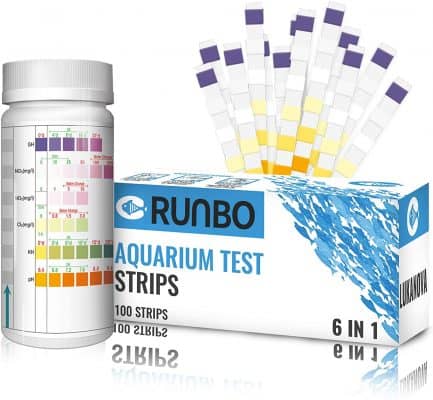
Editor’s Rating:
Why we like it: The Runbo Aquarium test strips come in a large kit of 100, so you won’t have to worry about restocking anytime soon! It measures six different aspects of water quality and gives you an overarching view of water performance in your tank.
Quick Facts:
- Accuracy: +/- 0.4°
- pH Range:4 – 8.4
- Power Source: NA
- Type: Manual
The worst part of manual pH meters is their non-reusability, but this kit takes care of the restocking issue! Each kit comes with 100 strips at an affordable price, so you won’t have to worry about running out anytime soon. The meter itself will test six different components of water, and you’ll only need to dip it in the water for 2 seconds before it gets an accurate reading. Strips can also be stored for up to 2 years and function.
If you’re not sure about buying 100 strips all at once, the API test strips come in smaller packs.
However, the range of pH only goes from 6.4 to 8.4, making this the smallest range on our list. In addition, as with all manual meters, this won’t be as accurate as some of the other digital options. If you have fish that need to live in acidic water or alkaline water, this kit also won’t be able to help out as much. The strips are also smaller and thinner, making it hard to compare against the provided manual.
The strips themselves look at pH, general hardness, free chlorine, carbonate, nitrate concentrations, and nitrite concentrations in the water. This means you’ll be getting a specialized look into exactly how well your aquarium suits the fish and plants living within it. The high-quality fiber it’s made of lets you get quick and accurate results, faster than most digital meters.
Pros
- Comes in an affordable set of 100 strips
- Tests six different elements of water, including the pH
- Only needs 2 seconds to get an accurate reading
- Can be stored for up to 2 years
- Made of high-quality fiber
Cons
- Very small pH range for testing
- Not as accurate as digital meters
- Strips are smaller and can be hard to compare to colors in the manual
7. Easiest pH Meter to Calibrate: Hayi Digital pH Meter for Aquarium Water
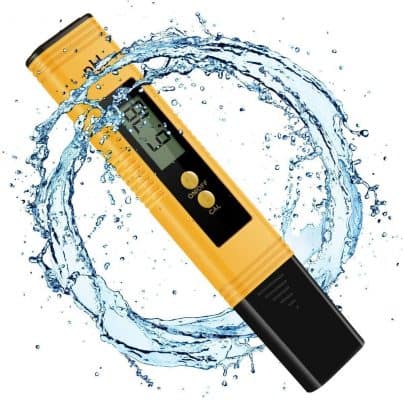
Editor’s Rating:
Why we like it: The Hayi digital pH meter comes pre-calibrated and with extra buffer powders, to make the calibration process easier for you. It even includes an automatic calibration button that you can press and takes the struggle out of first-time calibrations for many users.
Quick Facts:
- Accuracy: +/- 0.01°
- pH Range:0 – 14.0
- Power Source: 2 x 1.5V LR44 batteries
- Type: Digital
This pH meter comes with an automatic calibration function that can be changed depending on the water temperature and quality. In addition, when it arrives, you’ll receive three specialized pH buffer powders (at 4.01, 6.86, and 9.18 pH levels) so you won’t have to worry about making your own solution. The meter also comes pre-calibrated so you can use it as soon as you receive it, though you’ll want to recalibrate it weekly. A carrying case is also included for safe storage of the pH meter.
However, while the store page says that it has an accuracy of +/- 0.01, this can vary after extended use, growing more inaccurate over time. They’re also not as durable as some of the other meter options available, so you’ll have to be gentle when you’re working with this meter. This meter is also not waterproof unlike the Bluelab pH pen, so you’ll have to be careful when you’re using it for your aquarium.
This meter does come with a temperature sensor to compensate for the pH value, so you won’t have to worry too much about cold the water may be. In addition, it’s versatile and can be used to test the pH for many situations, from drinking water to aquariums to even swimming pools. It has a special non-slip design on the side as well so that you won’t accidentally drop it into the water when you’re using it.
Pros
- Comes with buffering powders for future calibration
- Pre-calibrated when it arrives and ready for use
- Comes with carrying case
- Automatic temperature calibration
- The non-slip grip makes it easy to use
Cons
- Grows inaccurate over extended usage
- Not waterproof
- Not as durable
8. Best pH Meter for Comprehensive Water Status: API Test Strips
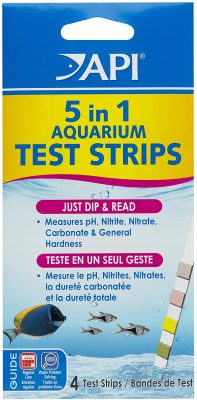
Editor’s Rating:
Why we like it: These API test strips offer you insight into the pH, general hardness, carbonate hardness, nitrite concentrations, and nitrate concentrations all on a single strip. It only takes 30 seconds before you get this general overview of how your aquarium water is doing.
Quick Facts:
- Accuracy: +/- 0.5°
- pH Range: 6.0 – 9.0
- Power Source: NA
- Type: Manual
The API test strips come in a pack of four, although you can buy larger ones in packs of 100 if you plan on testing often. Each strip tells you about more than just the pH in the tank and includes information on the general hardness, the carbonate hardness, nitrite ions, and nitrate ions as well. The strips only need to be dipped into water for less than a minute to gather a reading. It’s also one of the most affordable options for aquarium water testing, and it works with both freshwater and saltwater aquariums.
However, since this is a manual pH meter, it won’t be as accurate as the other meters. The colors only measure pH from 6.0 to 9.0, so if your aquarium water is outside that range you’ll want to invest in a different meter. It also only shows colors for pH in 0.5 increments from 6.0 to 9.0, and it is also less precise for the other water measurements as well. If you want strips that are slightly more precise, try the Tetry EasyStrips collection.
This strip will give you a comprehensive overall view of the pH in your aquarium tank, though each of the readings won’t be spot on. Keep in mind that the average pH will fluctuate from day to day regardless, so perhaps you won’t need an overly accurate testing kit. If you want to just try testing the waters once or twice irregularly, this meter is the one for you.
Pros
- Measures five different categories of water quality
- Needs less than a minute to gather reading
- A comprehensive overview of water status
- Affordable
- Works for saltwater and freshwater
Cons
- Less accurate readings
- Only measures pH from 6.0 to 9.0
9. Best Digital pH Meter for Beginners: Vivosun pH and TDS Meter Combo
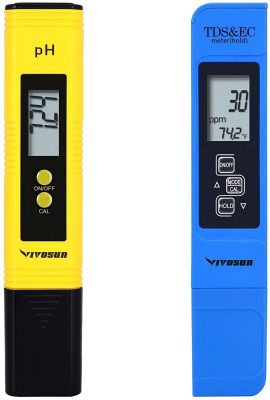
Editor’s Rating:
Why we like it: The Vivosun pH meter is affordable and easy to use for beginners who aren’t accustomed to taking pH readings for their tank. It only needs to be calibrated once a year, and it’s small and portable enough to be taken anywhere.
Quick Facts:
- Accuracy: +/- 0.02°
- pH Range:0 – 14.0
- Power Source: CR2 battery
- Type: Digital
The Vivosun pH meter is an affordable digital thermometer for your freshwater aquarium that’s powered by a CR2 battery. The battery can help it last up to 500 hours of use, and its automatic shut off time after 9 minutes of inactivity means that you won’t have to worry about charging it often. It also comes with a protective cap that you can place on the meter to keep the tip from getting damaged.
However, this meter is only useful for freshwater aquariums and won’t be able to measure the pH of saltwater. In addition, it’s also one of the few pH meters on this list that isn’t waterproof, so you’ll need to be extra careful not to submerge the entire meter when using it.
The display also only shows one number at a time, so you’ll have to toggle between readings by pressing the button. If you want an affordable option that has a light-up display, you should try the Pancellent water quality pH meter.
The upside of getting the Vivosun meter it’s a digital meter that comes calibrated (by a 1413 solution) and can be used for a year without being calibrated again. In addition, it also comes with a temperature sensor so it can adjust the pH accordingly depending on the water temperature. It’s also small, lightweight, and portable, so you can easily take it with you wherever you go.
Pros
- Comes calibrated
- Only needs to be calibrated once a year
- The battery lasts for 500 hours and meters
- Compensates for the water temperature
- Small, lightweight, and portable
Cons
- Cannot be used in saltwater aquariums
- Not waterproof
- Display only shows one number at a time
10. Best Affordable Digital pH Meter: Pancellent Water Quality Test Meter
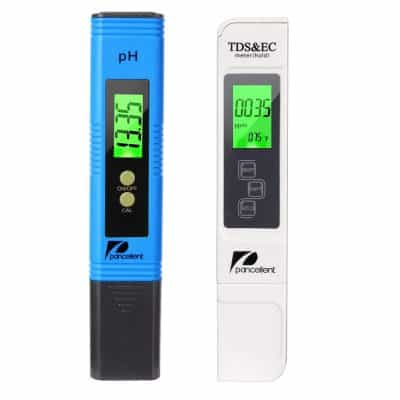
Editor’s Rating:
Why we like it: The Pancellent pH meter is affordable and accurate, so that you can rest assured that your aquarium water is in a safe zone for your fish. It’s one of the few digital meters that don’t cost a fortune—all while testing for pH, TDS (total dissolved solids), and conductivity in the water!
Quick Facts:
- Accuracy: +/- 0.01°
- pH Range:0 – 14.0
- Power Source: 2 x 1.5V LR44 batteries
- Type: Digital
The Pancellent meter is small, portable, and affordable, good for someone who wants to take pH readings without breaking their bank. It can function in temperatures from 32 to 140 degrees, making it a solid choice regardless of how hot or cold the water might be. In addition, it comes with a special protection cap and battery case for easy use.
Keep in mind that like many other cheaper options, this pH meter is not waterproof. As such, take care when using it in an aquarium so that only the tip gets wet. The instruction manual can be hard to understand.
The meter also doesn’t calibrate the pH automatically in regards to temperature, so you may want to get a small cup and let the water reach room temperature in the cup before using the meter. It does come with six packets of powder to help you create buffer solutions for the initial calibration.A probe that does adjust for temperature and is completely waterproof would be the Bluelab pH pen.
It also comes with a LED display that has a backlight, so that you can take recordings in dim environments as well. The meter works to test the pH, TDS, and conductivity – you just have to toggle between the measurements with a push of the button!
Pros
- Portable and affordable
- Works in 32 to 140 degree water
- Comes with buffer solution packets
- Tests pH, TDS, and conductivity
Cons
- Not waterproof
- Does not account automatically for temperature
- The instruction manual can be confusing to read
Guide to Picking the Perfect pH Meter
Each pH meter is unique in the way it’s designed, its accuracy, and even its functionality. From unpacking your first pH meter to picking out the perfect one for your aquarium, our full guide has you covered. Read more to figure out whether a manual or a digital pH kit is best for you.
What pH Should My Aquarium Be?
For a vast majority of plant and animal species, the ideal pH of a freshwater aquarium is anywhere between 6.8 to 7.6. A few fish, like some tetras, prefer the pH on the lower end of this spectrum and others, like cichlids, prefer things a touch high, but anything within this range won’t cause any problems.
Saltwater fish, on the other hand, tend to like pH levels between 8.0 and 8.4. Like with freshwater fish there are some exceptions, but most fish can tolerate anything within that range.
Though most fish will be perfectly happy in a thank that fits within one of these two ranges, some won’t—so be sure to double-check your fish here.
If your pH isn’t where it should be, pick up a pH meter and follow our guide to raising or lowering your pH.
Why Do I Need a pH Meter?
Knowing the pH of your tank lets you know how acidic or basic your tank might be. Values above 7.0 are basic, or alkaline, while values below a 7.0 are acidic. If it’s exactly a 7.0, then it’s considered to be neutral.
Depending on the fish that you own and the plants growing in your aquarium, having the wrong pH level could cause them to get sick and fall ill.
In addition, the pH levels of your tank may be constantly changing as you add in new fish and plants. It usually drops at night due to less plant respiration and photosynthesis, while rising in the daytime. Changing the water can also affect pH balance, so you’ll want to test often to makes sure it stays in a safe range.
Dangers of Low pH
If the pH in your tank falls too low below a 6.0, this can end up killing the nitrification bacteria naturally found in the water. As a result, it won’t be able to regulate the ammonia ions and nitrite concentrations in the water which are toxic to fish in larger quantities.
If left uncared for, the concentration of ammonia ions and nitrate will slowly increase until it ends up killing your fish. In addition, low pH can also cause extra mucous production from your fish and results in eye damage, hyperplasia (when the skin and gills grow thicker), and trouble breathing.
Dangers of High pH
When pH gets too high, while ammonium ions will decrease, actual ammonia concentrations in the water will increase. While ammonium ions are less toxic to fish when compared to ammonia, both are harmful and can end up hurting your fish and plants in the aquarium. Water that has higher pH levels can damage gills and eventually also kill your fish if left unchecked.
You’ll want to make sure that you keep the pH mostly balanced between the recommended levels for your various fish to make sure that all of them thrive in your tank.
Features to Look for in pH Meters
There is no “normal” pH that all fish prefer. Depending on the species of your fish and where it comes from, they all have various ranges of preferred pH levels. For example, while saltwater fish typically prefer a pH of at least 8.0, tropical fish from Brazil likes pH levels that range from 5.5 to even lower! Before purchasing fish for a tank, you’ll want to make sure it falls within the pH range of your water and in the range that your meter can measure.
However, one thing to keep in mind is that pH meters are designed for a variety of reasons, not just for aquarium tanks. While some pH meters made for testing soil can be used in your aquarium, you want to make sure that any meter you buy is waterproof. While you’re safer just investing in a pH meter that’s geared towards aquariums, gardening pH meters can work just as well, as long as they hold up in the water.
Automatic Temperature Calibration
When you’re looking for a pH meter, you’ll want to see if it comes with ATC, or automatic temperature calibration. At different heat levels, the pH of the tank can be read differently. As a result, meters that have this temperature calibration and sensor already built-in can save you a step from doing the math yourself to see what the pH level truly is.
Waterproofing
Not all pH meters are completely waterproof like the Bluelab pH pen. Some only have waterproof probes and won’t be able to be submerged at all. Before purchasing a pH meter, make sure you understand just how waterproof it is or isn’t.
Science Behind pH Meters
When it comes to measuring pH, manual kits and digital meters work in different ways to determine the correct pH of the water. We’ll be looking at the differences in both so you understand exactly how the meter measures your water acidity.
Manual pH Meters
Manual pH meters are coated with a chemical indicator that changes when it comes in contact with hydroxide and hydrogen atoms. Often, flavin is used to change into various colors. As a result, you’ll just have to match the color to the color key that the meter comes with when you order it.
Keep in mind that since colors come in a continuous range, these meters may not be as accurate as you try to visually match the right hues to the paper.
Our favorite manual pH meter is the Tetry EasyStrips collection.
Digital pH Meters
When it comes to digital meters, first you’ll have to understand the difference in water composition depending on its acidity. When water is more acidic, that means that it has more hydrogen ions that disassociate from water molecules. As a result, these ions are separate charges that float around the water and have a greater potential to produce an electric current.
However, basic solutions often compose of multiple hydroxide molecules that aren’t as likely to produce electric currents. The goal of the pH meter is to test how easy it is for the water to conduct a small amount of electricity, and return the resulting pH number from that calculation.
To make sure you get accurate readings, you’ll also need to calibrate it first so that it has a reference point for taking measurements.
Our favorite digital pH meter is the Apera AI209 Series.
Steps to Using a pH Meter
Once you buy a pH meter, you’ll want to make sure that you follow all the directions to get an accurate reading. If you have a manual meter, this is as easy as making sure that you leave the paper strip in the water for a long enough time. After the recommended amount of minutes that your kit says, you’ll be able to compare it to the color-coded key that comes with your purchase and pick the hue closest in shade to the paper strip.
Digital meters can be a bit trickier to use. If this if your first time, you’ll want to make sure you calibrate it first (which we get into here). After you have the meter and you’ve taken a small sample of water from your tank, you’ll first want to clean your meter with deionized water. After drying it, place it in the test solution and leave it there for several minutes so that it can stabilize. After reading the meter, simply dry it off and store it in a safe place.
Calibrating a Digital pH Meter
When it comes to calibrating your digital pH meter, the most reliable way is to use buffering solutions. These are solutions with a known pH, and you can order them online. However, even if you don’t have a buffering solution, you’ll still be able to calibrate it after purchasing a few basic ingredients at the store.
How often you’ll need to calibrate your meter also depends on the pH meter that you bought. If it has higher accuracy, you’ll want to calibrate it before each use. However, lower accuracy meters will only need to be calibrated every week or biweekly. In addition, you’ll want to calibrate it after testing it in a strongly basic or acidic solution.
Our favorite easy-to-calibrate pH meter would be the Hayi pH meter.
Calibration With Buffering Solutions
When you have a buffering solution, you can specifically program your meter to read the pH for that solution. First, you’ll want to get a neutral solution with a pH of 7 and leave your meter in the water for a few minutes. Once you’re sure that the reading is stabilized, you can adjust the meter to display 7 as well.
After that, you’ll want to repeat the process with all other buffering solutions. Make sure you have at least one basic solution and one acidic solution for the best results. Each time, you’ll want to clean off the pH meter with water and then wipe it so that it’s dry. The key is making sure that it stays in each solution for long enough to get an accurate reading, and knowing the various pHs of all your buffering solutions.
Making Your Own Buffering Solution
If you don’t have buffering solutions readily available, it’s easy to make your own! If your local store sells buffer tablets, you can simply purchase them and add them to the recommended amount of water. However, if you can’t find any tablets, you may have to purchase some MKP (monopotassium phosphate) and KOH (potassium hydroxide).
The downside is that you’ll need to use a pH test strip or borrow an already calibrated pH meter from a friend to make sure you add enough of each chemical. After filling up a container of water about three-fourths of the way, you should add in about 10 grams of MKP. Once the solids dissolve, use your pH test strip or meter and begin slowly adding in KOH flakes until you reach a pH around 7, to create your neutral buffering solution.
To make a more acidic buffer, add in 20 grams of citric acid at the start instead of MKP, and then begin adding in KOH until you’re at the desired pH level. To get a basic buffer solution, you’ll want to use a weaker base such as ammonia solution and ammonium chloride. Each time, simply add in ingredients slowly with the pH strip or meter in the water until you’re at the desired level. Once you have the buffer solution, you can begin calibrating your new digital pH meter.
Manual or Digital Meters?
When it comes to choosing a meter, manual ones are more suited for beginners who only want to test infrequently. They don’t have any of the calibration issues that digital meters have, and you also won’t have to worry about caring for them and cleaning them after each use. However, all manual meters are not reusable so the affordable price will add up if you have to buy multiple boxes for frequent testing.
Digital meters require more involvement from your side as you create the buffer solutions and deal with calibration (though some are easier to calibrate than others). They can also adjust for temperature which manual kits aren’t always able to do. This comes at a higher upfront cost when you make the initial purchase, though it will balance out if you plan on testing pH frequently over an extended period of time. You’ll also get higher accuracy in your readings.
One last thing to keep in mind is knowing how much information you want from your tank. A lot of manual pH kits also test for things like nitrite and nitrate concentrations, as well as free chlorine ions and the general hardness of the water. Digital meters will often only tell you the pH of water, and while it is more accurate, remember that your fish can survive and thrive in a wider range of pH levels.
How to Change My Aquarium’s pH Level
If you notice that your pH level is significantly different from the recommended levels in the tank, you’ll want to make sure you fix that before any of your fish fall ill. However, you don’t want to be too drastic when you’re changing the pH levels – a stable pH environment is the most important thing when it comes to your aquarium.
Adjust it slowly over the course of multiple days, since even a change of 0.3 in pH level can end up being deadly for your fish. In addition, you don’t have to get the pH level perfectly in the middle of the recommended level for your fish. As long as it falls within the acceptable range for your pet, keeping it stable will help your fish more than changing the pH to be slightly more optimal. With that being said, here are ways you can change the pH level of your tank.
Raising pH Level
Raising the pH level can easily be done by regularly changing the water in the tank. If you have a larger aquarium, you may have to change the water out a little bit at a time. In addition, getting rid of some of the extra food and waste can also help raise pH levels (or at the very least, counter dropping pH levels).
Adding crushed coral or limestone can also increase the pH in the water, though it doesn’t take much of either to raise the level. You’ll want to add it very slowly to make sure that it doesn’t rise above the recommended level. Baking soda can also be added, though you’ll need to constantly add it over a long period of time. Typically, one teaspoon of baking soda for five gallons of water is suitable.
Lowering pH Level
The process of lowering pH in your tank is much harder than raising it. However, filtering the water through peat moss can lower the pH over time. In addition, you can try adding types of driftwood to decrease pH, or you can pump in more carbon dioxide at a reasonable rate. While there are some chemicals available in the market for lowering pH, these are temporary solutions rather than permanent pH changes.
Digital pH Meter Care Tips
Good digital pH meters can be very expensive, so you’ll want to make sure you take good care of it. If you’re careful, you may be able to use it for a lifetime which justifies the higher upfront cost. Some kits, like the Apera AI209 Series, come with care kits and brushes. Below are some tips for how to get the most out of your meter and keep it working for a long time.
Keep It Calibrated
First, you’ll want to calibrate it often, so that it gives accurate readings each time you use it. Not calibrating a pH meter can lead to inaccurate and wrong results, which is detrimental to helping the health of your tank. In addition, you’ll want to find a safe, dry place to store it and try to keep the tip of the meter covered with a cap that it comes with. Don’t get the meter wet when it’s not being used.
Keep It Clean
Each time after use, you need to wash it off and get rid of any solution on it. In addition, you don’t want to touch the sensor electrodes or reference cell at the tip of the meter, since the oil on your finger can end up damaging the meter and messing up future readings. Read all instructions to make sure you don’t miss anything.
Keep It Protected
As long as you handle your pH meter with care, it should last for years of use. Keeping it away from temperature and humidity extremes and doing your best to keep it dry goes a long way when it comes to these meters. One last tip is to swirl the meter in solution before and after using it to get rid of any potential air bubbles.
Final Words
Picking out the perfect pH meter ensures that you have a healthy aquarium, with fish and plants that are thriving every day. Do your research on the specific species held within your tank, and make sure that your pH levels don’t deviate too much from the recommended amount. With proper care and usage of pH meters and kits, soon you can be confident that your tank will be the perfect environment for all the living beings inside.




